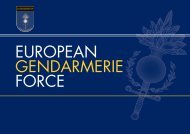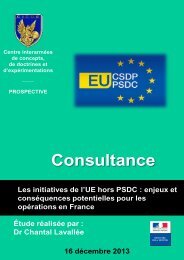Conference
science-research-bulletin-2013-conference
science-research-bulletin-2013-conference
You also want an ePaper? Increase the reach of your titles
YUMPU automatically turns print PDFs into web optimized ePapers that Google loves.
EUROPEAN POLICE SCIENCE AND RESEARCH BULLETIN<br />
SPECIAL CONFERENCE EDITION<br />
has a number of ‘regional’ frameworks, which<br />
exist bilaterally and multilaterally between some<br />
of the states and territories. The difference<br />
between these and EU regional strategies is that<br />
they have not been formalised through treaties<br />
and agreements and therefore have no power to<br />
influence federal law. Australia and the EU show<br />
most similarities with regard to ‘compensatory’<br />
strategies. Both employ liaison officers in the<br />
other jurisdictions and offer common education<br />
and training, as well as other practitioner forums<br />
to overcome the lack of legal frameworks and<br />
harmonisation. On the sociological rather than<br />
the legal level, many similarities do therefore<br />
exist.<br />
With regard to the EU, one of the most important<br />
developments in the area of police cooperation<br />
was the establishment of a common legal<br />
framework under the Schengen Agreement<br />
(Agreement between the Governments of the<br />
States of the Benelux Economic Union, the Federal<br />
Republic of Germany and the French Republic on<br />
the Gradual Abolition of Checks at their Common<br />
Borders 1985), which had the effect of relaxing<br />
common border controls. The Schengen<br />
Agreement, together with all the decisions of the<br />
Executive Committee, was supplemented by the<br />
1990 Convention Implementing the Schengen<br />
Agreement (Schengen Convention or Schengen<br />
Acquis, D’Oliveira, 1996, pp. 268-269). The<br />
Schengen Convention provided for the gradual<br />
abolition of borders between the EU Member<br />
States signatories, with the view to creating an<br />
internal market without frontiers, enabling the<br />
free movement of goods and persons (Europa,<br />
Summaries of Legislation, 2014). While it is a<br />
harmonised EU legal framework today, the<br />
Schengen Convention commenced as a regional<br />
initiative and borrowed from other regional<br />
frameworks, such as the Benelux and Nordic<br />
countries cooperation and the informal Dutch,<br />
Belgium and German cooperation network<br />
‘NebedeagPol’, which highlights the importance<br />
of regional frameworks to stimulate innovation<br />
and enhanced police cooperation in the EU.<br />
It is debatable whether the abolition of internal<br />
borders in the EU genuinely heightened the risks<br />
of cross border crime, and therefore justified<br />
enhanced cooperation under the Schengen<br />
Convention, or whether the calls for greater<br />
cooperation were simply opportunistic political<br />
rhetoric (Busch, 1996, p. 319; Anderson, 1994,<br />
pp. 3, 9-11). It is reasonable to assume that<br />
suspected criminals entering neighbouring<br />
countries, and thereby into another jurisdiction,<br />
pose difficulties for the police pursuing them,<br />
such as obtaining arrest warrants, permission<br />
to continue the pursuit or general assistance of<br />
the police from the country entered (Hertweck,<br />
2005, p. 721; Schneider, 1998, p. 306; Storbeck,<br />
1993, p. 175). A heightened significance of police<br />
cooperation in the EU in the last 20 years can<br />
probably be attributed to a number of factors,<br />
apart from the perceived increased risks of<br />
cross-border crime flowing from the abolition<br />
of border-controls. These include, for example,<br />
the effects of globalisation, terrorism, organised<br />
crime and, generally, the increased mobility<br />
of offenders (see inter alia, Bowling, 2009;<br />
Busch, 1996; and in relation to the impact of<br />
globalisation on policing, Reiner, 1992; Sheptycki<br />
2009a and b). These factors have clearly affected<br />
the EU and Australia alike.<br />
In addition to the Schengen regime, many<br />
regional cooperation frameworks have<br />
developed in the EU: for example, the Nordic<br />
Police and Customs Cooperation (in Norwegian:<br />
PTN) (Gammelgård, 2001, p. 232), the Benelux<br />
cooperation (Treaty Concerning Extradition and<br />
Mutual Assistance in Criminal Matters between<br />
the Kingdom of Belgium, the Grand Duchy of<br />
Luxembourg and the Kingdom of the Netherlands),<br />
the Cross Channel Intelligence <strong>Conference</strong><br />
(CCIC) (Gallagher, 2002, p. 121), the Meuse-<br />
Rhine Euroregion cooperation (Spapens, 2008,<br />
225-226) and numerous Police and Customs<br />
Cooperation Centres (PCCCs) (Mitteldeutsche<br />
Polizeiakademie, 2010; Overview of PCCCs,<br />
2006).<br />
While enhanced regional cooperation could be<br />
regarded as beneficial, it has been claimed to<br />
lead to the emergence of a so-called ‘patchwork’<br />
system of cooperation (Benyon, 1994). This<br />
can also be observed in the Australian context.<br />
Being political entities consisting of multiple<br />
jurisdictions, some of those jurisdictions have<br />
developed stronger links with each other and<br />
hence engage in more cooperation, while others<br />
have remained excluded from more advanced<br />
practices. While in the EU many neighbouring<br />
states have developed bilateral and multilateral<br />
treaties and agreements to enhance cross-border<br />
cooperation, a multitude of EU initiatives have<br />
equally developed to improve cooperation and<br />
set minimum standards in certain areas (Böse,<br />
2007, pp. 235-279). Due to the resulting diversity<br />
of bilateral, multilateral and EU strategies, the<br />
creation of an overarching legal framework<br />
116





